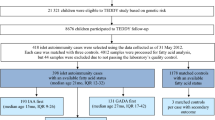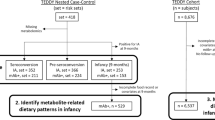Abstract
Background/Objectives:
N-3 (omega-3) fatty acids have been reported to decrease the risk for development of β-cell autoimmunity and clinical type I diabetes. We set out to examine whether different serum fatty acids are associated with the development of advanced β-cell autoimmunity in children carrying human leukocyte antigen DQ β-1 (HLA-DQB1)-conferred susceptibility to type I diabetes.
Subjects/Methods:
Within a cohort, serum total fatty acid composition of 108 children with advanced β-cell autoimmunity and of 216 matched persistently autoantibody-negative controls was analyzed using gas chromatography. Non-fasting serum samples were obtained annually at the ages of 1–6 years. Conditional logistic regression was applied to analyze the associations between advanced β-cell autoimmunity and serum fatty acids.
Results:
The serum fatty acid profile of myristic acid (odds ratio (OR) 1.48, 95% confidence interval (CI) 1.09–2.00, P=0.011), pentadecanoic acid (OR 1.65, 95% CI 1.19–2.28, P=0.003), palmitoleic acid isomers 16:1 n-7 (omega-7) (OR 1.41, 95% CI 1.03–1.92, P=0.030) and 16:1 n-9 (omega-9) (OR 1.45, 95% CI 1.05–2.01, P=0.026) and conjugated linoleic acid (OR 1.67, 95% CI 1.16–2.41, P=0.006) closest to the time of the appearance of multiple autoantibodies were positively associated with the risk of advanced β-cell autoimmunity after adjustment for potential confounding factors. Serum linoleic acid showed inverse, marginal association with the end point.
Conclusions:
Serum biomarkers of milk and ruminant meat fat consumption are directly associated and linoleic acid is inversely associated with advanced β-cell autoimmunity in children with HLA-conferred susceptibility to type I diabetes.
This is a preview of subscription content, access via your institution
Access options
Subscribe to this journal
Receive 12 print issues and online access
$259.00 per year
only $21.58 per issue
Buy this article
- Purchase on Springer Link
- Instant access to full article PDF
Prices may be subject to local taxes which are calculated during checkout

Similar content being viewed by others
References
Aguilera CM, Gil-Campos M, Cañete R, Gil Á (2008). Alterations in plasma and tissue lipids associated with obesity and metabolic syndrome. Clin Science 114, 183–193.
Åkerblom HK, Virtanen SM, Ilonen J, Savilahti E, Vaarala O, Reunanen A et al. (2005). Dietary manipulation of beta cell autoimmunity in infants at increased risk of type 1 diabetes: a pilot study. Diabetologia 48, 829–837.
Arab L (2003). Biomarkers of fat and fatty acid intake. J Nutr 133, 925S–932S.
Baur LA, O’Connor J, Pan DA, Wu BJ, O’Connor MJ, Storlien LH (2000). Relationships between the fatty acid composition of muscle and erytrocyte membrane phospholipid in young children and the effect of type of infant feeding. Lipids 35, 77–82.
Borgan O, Samuelsen SO (2003). A review of cohort sampling designs for Cox regression model: potentials in epidemiology. Norsk Epidemiologi 13, 239–248.
Borgan O, Goldstein L, Langholz B (1995). Methods for the analysis of sampled cohort data in the Cox proportional hazards model. Ann Stat 23, 1749–1778.
Crowe FL, Skeaff CM, Green TJ, Gray AR (2006). Serum fatty acids as biomarkers of fat intake predict serum cholesterol concentrations in a population-based survey of New Zealand adolescents and adults. Am J Clin Nutr 83, 887–894.
Folch J, Lees M, Stanley GHS (1957). A simple method for the isolation and purification of total lipids from animal tissues. J Biol Chem 226, 497–509.
Fritsche K (2006). Fatty acids as modulators of the immune response. Annu Rev Nutr 26, 45–73.
Hughes DA, Pinder AC, Piper Z, Johnson IT, Lund EK (1996). Fish oil supplementation inhibits the expression of major histocompatibility complex class II molecules and adhesion molecules on human monocytes. Am J Clin Nutr 63, 267–272.
Hyppönen E, Virtanen SM, Kenward MG, Knip M, Åkerblom HK (2000). Obesity, increased linear growth, and risk of type 1 diabetes mellitus in children. Diabetes Care 23, 1755–1760.
Innis SM (2007). Dietary lipids in early development: relevance to obesity, immune and inflammatory disorders. Curr Opin Endocrinol Diabetes Obes 14, 359–364.
Katan MB, Deslypere JP, Birgelen APM, Pendens M, Zegwaard M (1997). Kinetics of the incorporation of dietary fatty acids into serum cholesteryl esters, erythrocyte membranes, and adipose tissue: an 18-month controlled study. J Lipid Res 38, 2012–2022.
Kew S, Mesa MD, Tricon S, Buckley R, Minihane AM, Yaqoob B (2004). Effects of oils rich in eicosapentaenoic and docosahexaenoic acids on immune cell composition and function in healthy humans. Am J Clin Nutr 79, 674–681.
Kleemann R, Scott FW, Wörz-Pagenstert U, Ratnayake WMN (1998). Impact of dietary fat on Th1/Th2 cytokine gene expression in the pancreas and gut of diabetes-prone BB rats. J Autoimmun 11, 97–103.
Kukko M, Kimpimäki T, Korhonen S, Kupila A, Simell S, Veijola R et al. (2005). Dynamics of diabetes-associated autoantibodies in young children with human leukocyte antigen-conferred risk for type 1 diabetes recruited from the general population. J Clin Endocrinol Metab 90, 2712–2717.
Kupila A, Muona P, Simell T, Arvilommi P, Savolainen H, Hämäläinen AM et al. (2001). Feasibility of genetic and immunological prediction of type 1 diabetes in a population-based birth cohort. Diabetologia 44, 290–297.
Mohan IK, Das UN (2001). Prevention of chemically induced diabetes mellitus in experimental animals by polyunsaturated fatty acids. Nutrition 17, 26–151.
Moilanen T (1987). Short-term biological reproducibility of serum fatty acid composition in children. Lipids 22, 250–252.
Nikkari T, Räsänen L, Viikari J, Åkerblom HK, Vuoti I, Pyörälä K et al. (1983). Serum fatty acids in 8-year-old Finnish boys: correlations with qualitative dietary data and other serum lipids. Am J Clin Nutr 37, 848–854.
Norris JM, Yin X, Lamb MM, Barriga K, Seifert J, Hoffman M et al. (2007). Omega-3 polyunsaturated fatty acid intake and islet autoimmunity in children at increased risk for type 1 diabetes. JAMA 298, 1420–1428.
Okada T, Ruruhashi N, Kuromori Y, Miyashita M, Iwata F, Harada K (2005). Plasma palmitoleic acid content in children. Am J Clin Nutr 82, 747–750.
Sabin MA, de Hora M, Holly JMP, Hunt LP, Ford AL, Williams SR et al. (2007). Fasting nonesterified fatty acid profiles in childhood and their relationship with adiposity, insulin sensitivity, and lipid levels. Pediatrics 120, 1426–1433.
Schrezenmeir J, Jagla A (2000). Milk and diabetes. J Am Coll Nutr 19, 176S–190S.
Stene LC, Joner G (2003). Use of cod liver oil during the first year of life is associated with lower risk of childhood-onset type 1 diabetes: a large, population-based, case-control study. Am J Clin Nutr 78, 1128–1134.
Stoffel W, Chu F, Ahrens Jr EH (1959). Analysis of long-chain fatty acids by gas-liquid chromatography. Micromethod for preparation of methyl esters. Anal Chem 31, 307–308.
Suresh Y, Das UN (2001). Protective action of arachidonic acid against alloxan-induced cytotoxicity and diabetes mellitus. Prostaglandins Leukot Essent Fatty Acids 64, 37–52.
Uusitalo L, Nevalainen J, Niinistö S, Alfthan G, Sundvall J, Korhonen T et al. (2008). Serum α- and γ-tocopherol concentrations and risk of advanced beta cell autoimmunity in children with HLA-conferred susceptibility to type 1 diabetes mellitus. Diabetologia 51, 773–780.
Vaarala O, Knip M, Paronen J, Hämäläinen AM, Muona P, Väätäinen M et al. (1999). Cow's milk formula feeding induces primary immunization to insulin in infants at genetic risk for type 1 diabetes. Diabetes 48, 1389–1394.
Verge CF, Howard NJ, Irwig L, Simpson JM, Mackerras D, Silink M (1994). Environmental factors in childhood IDDM. Diabetes Care 17, 1381–1389.
Virtanen SM, Läärä E, Hyppönen E, Reijonen H, Räsänen L, Aro A et al. (2000). Cow's milk consumption, HLA-DQB1 genotype and IDDM: a nested case-control study of siblings of children with diabetes. Diabetes 49, 912–917.
Virtanen SM, Räsänen L, Aro A, Lindström J, Sippola H, Lounamaa R et al. (1991). Infant feeding in Finnish children <7 yr of age with newly diagnosed IDDM. Diabetes Care 14, 415–417.
Wahlberg J, Vaarala O, Ludvigsson J (2006). Dietary risk factors for the emergence of type 1 diabetes-related autoantibodies in 2.5 –year-old Swedish children. Brit J Nutr 95, 603–608.
Wallace FA, Miles EA, Evans C, Swtock TE, Yaqoob P, Calder PC (2001). Dietary fatty acids influence the production of Th1- but not Th2-type cytokines. J Leucocyte Biol 69, 449–457.
Wolk A, Furuheim M, Vessby B (2001). Fatty acid composition of adipose tissue and serum lipids are valid biological markers of dairy fat intake in men. J Nutr 131, 828–833.
Ylönen K, Virtanen SM, Ala-Venna E, Räsänen L (1996). Composition of diet in relation to fat intake of children aged 1–7 years. J Hum Nutr Diet 9, 207–218.
Zock PL, Mensink RP, Harryvan J, de Vries JHM, Katan M (1997). Fatty acids in serum cholesteryl esters as quantitative biomarkers of dietary intake in humans. Am J Epidemiol 145, 1114–1122.
Acknowledgements
We thank the DIPP research staff and laboratory staff for excellent collaboration. We are grateful to Carina Kronberg-Kippilä, Tommi Korhonen, Tiina Keippilä, Minna Pekkala, Hanna Haponen and Harri Sinkko for their skilful assistance. We also thank the children and parents who participated. We are grateful to Antti Aro for constructive comments on the paper. The study was supported by the European Foundation for the Study of Diabetes (EFSD), Doctoral Programs in Public Health, the Academy of Finland (Grants 63672, 79685, 79686, 80846, 201988, 210632 and 129492), the Finnish Diabetes Research Foundation, the Juho Vainio Foundation, the Yrjö Jahnsson Foundation, Competitive Research Funding of the Pirkanmaa Hospital District, Tampere University Hospital, Medical Research Funds, Turku, Oulu and Tampere University Hospitals, JDRF (Grants 197032, 4–1998–274, 4–1999–731, and 4–2001–435), Novo Nordisk Foundation and the EU Biomed 2 Program (BMH4-CT98–3314).
Author information
Authors and Affiliations
Corresponding author
Ethics declarations
Competing interests
The authors declare no conflict of interest.
Additional information
Supplementary Information accompanies the paper on European Journal of Clinical Nutrition website
Supplementary information
Rights and permissions
About this article
Cite this article
Virtanen, S., Niinistö, S., Nevalainen, J. et al. Serum fatty acids and risk of advanced β-cell autoimmunity: a nested case–control study among children with HLA-conferred susceptibility to type I diabetes. Eur J Clin Nutr 64, 792–799 (2010). https://doi.org/10.1038/ejcn.2010.75
Received:
Revised:
Accepted:
Published:
Issue Date:
DOI: https://doi.org/10.1038/ejcn.2010.75
Keywords
This article is cited by
-
Dietary fatty acid intake in childhood and the risk of islet autoimmunity and type 1 diabetes: the DIPP birth cohort study
European Journal of Nutrition (2022)
-
Consumption of red meat, genetic susceptibility, and risk of LADA and type 2 diabetes
European Journal of Nutrition (2021)
-
The association between dairy products consumption with risk of type 1 diabetes mellitus in children: a meta-analysis of observational studies
International Journal of Diabetes in Developing Countries (2021)
-
The oxylipin profile is associated with development of type 1 diabetes: the Diabetes Autoimmunity Study in the Young (DAISY)
Diabetologia (2021)
-
Children’s erythrocyte fatty acids are associated with the risk of islet autoimmunity
Scientific Reports (2021)



